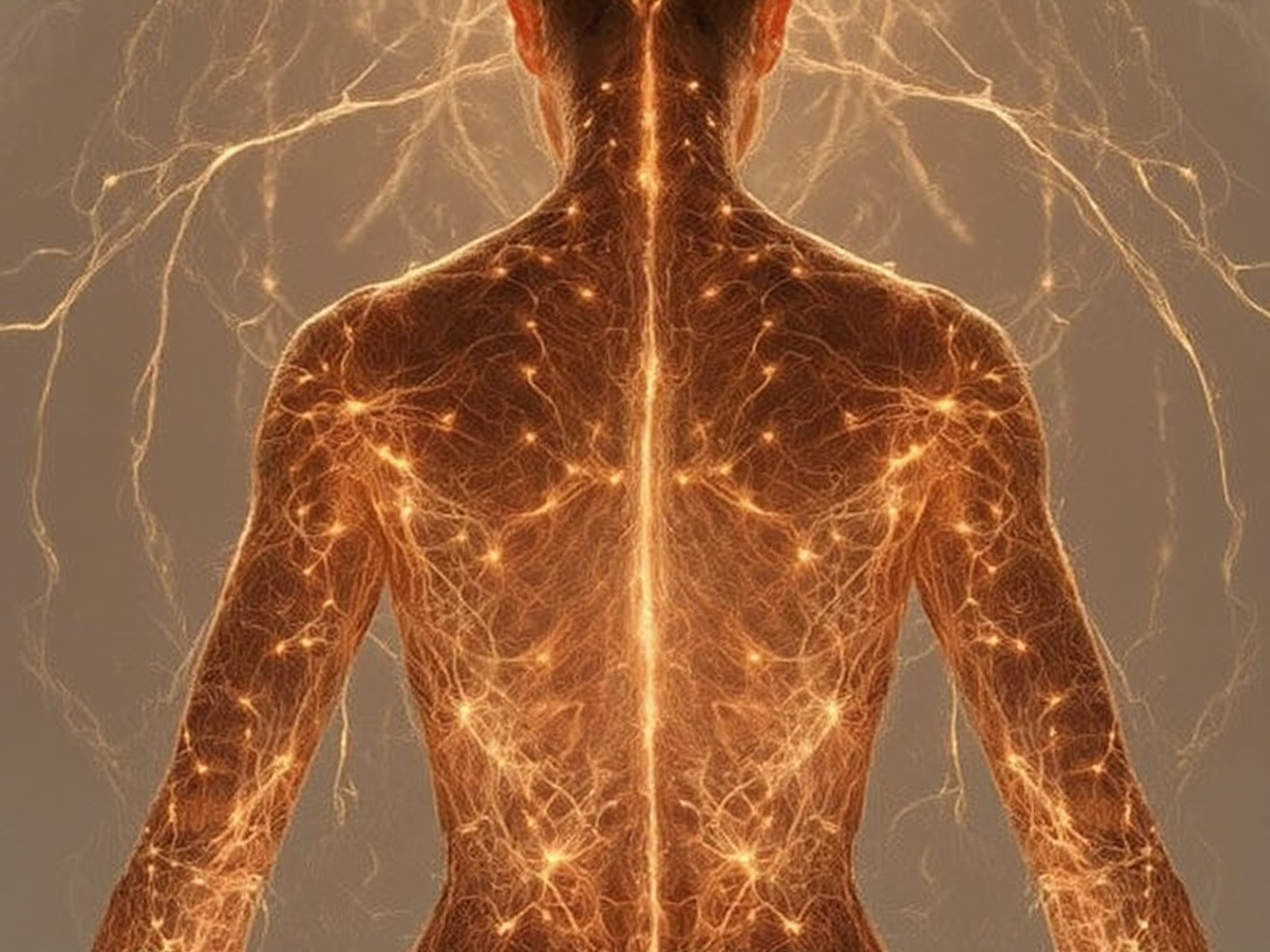Heal pain, tension, and dysfunction in the body through targeted fascia release

Transform Your Body From the Inside Out
The Fascia Remedy is a revolutionary approach to pain relief and movement restoration that addresses what most treatments miss: fascia—the connective tissue web that wraps around every muscle, bone, nerve, organ, and joint in your body.
When fascia becomes restricted, adhered, or dehydrated, you experience chronic pain, limited mobility, and that feeling of being "stuck" in your body. The Fascia Remedy focuses on HOW to properly release fascia and WHERE to do it for lasting results.
Feel the Difference for Yourself
Get started today with my FREE Unlock Your Hips 3 day video series! Learn how simple it can be to release restrictions affecting your pain, tension, and performance levels when you use your foam roller in this specific way (hint: it’s not rolling on it).
Need Relief?
You don’t have to live in pain or tension! Whether you’re dealing with low back pain, text neck, plantar fasciitis, shoulder tension, or that feeling of just being “stuck” in your body—fascia work can help you move, feel, and function better.
The Fascia Remedy is designed to help you get to the root cause of pain, not just mask the symptoms. Through targeted fascia release and movement-based techniques, you can restore hydration, mobility, and freedom throughout your entire body.
✨ Ways to Get Relief:
Self-Release Courses: Learn powerful fascia release techniques using simple recovery tools like foam rollers and massage balls.
Workshops & Classes: Join in-person or virtual sessions to experience guided fascia release and learn how to move with ease again.
1:1 Sessions: Experience hands-on (or “foot-on”) bodywork for customized, transformative results.
What Is Fascia & Why Does It Matter?
Fascia is your body’s three-dimensional web of connective tissue—like cling wrap that holds everything together. When it’s healthy, movement feels fluid, recovery is faster, and your body functions at its best. When it’s restricted, it can cause pain, stiffness, and dysfunction.
Here’s why fascia is key to understanding (and relieving) pain:
It contains more pain receptors than any other tissue in the body
It stores stress, trauma, and emotional tension
It connects everything—your structure, posture, and movement patterns. That’s why hip tension can cause back pain or shoulder restrictions can lead to carpal tunnel symptoms
The spot that hurts is rarely the source of the problem
Until recently, fascia was completely overlooked in medical training—researchers literally threw it away to study the muscles underneath. Now, new science shows it’s the missing link in how we move, heal, and feel.massage, physical therapy, chiropractic, stretching
Get Certified
The Fascia Remedy offers continuing education courses and certifications for wellness professionals, coaches, and movement enthusiasts who want to help people (or themselves) experience lasting pain relief and freedom through fascia-based work.
Fascia is the bridge between the physical and emotional body—and understanding how to work with it opens a whole new level of transformation for your clients.
Through a combination of online and in-person training, you’ll learn:
How to assess and release fascial tension throughout the body
How to identify root causes of pain patterns (not just where it hurts)
How to rehydrate and re-pattern fascia head to toe with recovery tools
How to use somatic and nervous system-informed movement to create real, lasting change
Hands-on/Foot-on bodywork techniques unique to The Fascia Remedy method
Whether you’re a yoga teacher, massage therapist, strength coach, or curious movement geek—this training will expand how you understand and help the human body.
Hi, I'm Julia!
I'm Julia Blackwell (BS, CKP, CRP, PAS) and I've been helping thousands resolve pain, restore movement, and feel amazing in their body since 2011.
After standard Western medicine treatments failed to help with severe nerve damage in my arm at birth, I deeply understand how frustrating and hopeless the process of looking for answers can be.
When I finally discovered fascia and began learning its language, I knew I had found the missing piece in most approaches: if we want to change to change how muscles, nerves, organs, bones, and joints operate, we have to address the one system that holds those structures in place: FASCIA!
My methodology, The Fascia Remedy, is a combination of powerful fascia release techniques, postural alignment exercises, and trauma-informed tactics that has earned me the nickname “The Pain Relief Wizard" from my community of both professional athletes and everyday movers.
The Fascia Remedy's unique and effective approach to discovering the root source of pain and limitations in the body has many who experience it calling it "magic." I'm excited for the opportunity to share what I've learned with you!
What My Clients Are Saying
Read the Latest Blog:
FAQs
-
Fascia is the body’s intricate web of connective tissue. It wraps around and weaves through everything—muscles, bones, nerves, blood vessels, even your organs. Think of it like the cling wrap that holds your whole body together. When it’s healthy, fascia helps you move freely, stay flexible, recover quickly, and enables all your other bodily systems (like lymphatic, digestive, circulatory, etc) function optimally. When it’s restricted, things start to hurt, tighten, and feel “off.”
-
Because until recently, fascia was completely overlooked in anatomy and medical training. Researchers would literally cut it away and throw it in the trash just to study the muscles or nerves underneath.
Thankfully, that’s changing—there are now more and more studies (even The New York Times has covered it) showing how fascia impacts health, pain, and movement. The problem: is most standard treatments still haven’t caught up.
Doctors, trainers, and therapists were taught to think only in terms of muscles, bones, and joints. Now we know fascia is full of pain receptors, stores stress, and plays a massive role in how we move. It’s the missing link for understanding so many cases of stubborn pain and tension.
-
Yes! Fascia is packed with nerve endings—pain receptors, pressure sensors, and proprioceptors (the ones that tell your brain where your body is in space). In fact, fascia has more receptors than any other tissue in the body—making it our most highly sensitive organ. That means your body awareness, coordination, pain sensations, and even stress responses come from fascia.
-
Yes and no. Massage definitely influences fascia—especially the myofascia (the fascia around muscles) and even the lymphatic system, which sits closer to the skin. Since fascia is everywhere, any massage is going to touch it in some way.
The catch? Most traditional massage misses the key ingredients for lasting change. To truly reset fascia, you need active movement to interrupt old patterns, and you have to look beyond the spot that hurts—because pain is rarely the actual problem.
That’s why many people feel amazing after a massage… but only for a little while. Without movement and the right type of pressure, fascia tends to snap back to its old, sticky patterns once the “feel-good” effect wears off.
-
Yes! Fascia isn’t just a physical tissue—it’s deeply connected to your nervous system and even communicates within itself. Stress, trauma, and even daily anxiety can cause your body to brace, tighten, and hold tension without you realizing it. Over time, that “holding pattern” gets stored in the fascia, almost like your body is wearing emotional armor.
That’s why people often describe feeling like stress is stuck in their body, or why emotions sometimes come up during a release session. Your fascia and nervous system work hand-in-hand, so when fascia is restricted, your body can stay locked in fight-or-flight mode.
The good news? When we release fascia in the right way, we’re not just freeing up movement—we’re also sending powerful safety signals to the nervous system, helping your body (and mind) relax, reset, and heal. -
Completely. Muscles contract and relax, but fascia doesn’t work the same way—it’s more like a cling wrap or spiderweb that can stick to itself and surrounding tissues. Releasing fascia isn’t about forcing a muscle to relax—it’s about restoring glide, hydration, and communication so muscles, nerves, and joints can do their jobs properly.
-
In most cases, this work actually complements what you’re already doing. It can enhance the results of other therapies—but here’s the key difference: most standard approaches focus on symptoms at the site of pain, rather than the root cause.
Here’s how The Fascia Remedy stands apart:
Massage can be wonderful for relaxation, lymphatic drainage, and mental health—but without active movement to retrain your patterns, the results are often temporary.
Stretching only works in one direction, while fascia is three-dimensional. It doesn’t address fascial adhesions—and sometimes can even make pain worse.
Chiropractic and physical therapy often target isolated muscles and joints, but don’t fully consider how the fascial system connects the entire body as one unit.
Foam rolling is a great tool, but when used without specific techniques or movement integration, it doesn’t create lasting change.
The Fascia Remedy combines targeted fascia release with intentional movement and trauma-informed somatic principles to address the true root cause, rewire your nervous system, and create results that last.
-
Flexibility isn’t really the best marker of health or athletic ability. What actually matters is mobility—the ability of your joints to glide fully and freely through their range of motion. When your joints are mobile, flexibility tends to come naturally.
Here’s where fascia comes in: fascia is a three-dimensional structure. If we want to change it, we have to work it in a three-dimensional way. Most traditional stretching only pulls tissue in one direction, which doesn’t address fascial tension or adhesions. That’s why stretching often feels good for a moment but doesn’t create lasting change.
By working directly with fascia, you’re improving mobility, athletic performance, and the overall “looseness” and freedom in your body. So yes, fascia release supports flexibility—but what we’re really after is full-body mobility and functional movement, not just being bendy.
-
Fascia is often the hidden culprit behind back pain. When fascia in your hips, legs, or even shoulders gets tight, it can tug on your spine and create imbalances that show up as pain. On top of that, the fascia in your lower back has one of the highest concentrations of pain receptors in the entire body, which makes it extra sensitive and quick to send those “warning signals.”
Here’s the key: the spot that hurts usually isn’t the real problem. That’s why you can stretch your back, get massages on your back, or even have spine adjustments—and the pain still comes back. The fastest path to lasting relief is releasing fascia in the right areas to restore balance through the whole chain.
-
The truth is, almost every ache, pain, or issue in the body has a fascial component.
Here’s a list of ailments that unhealthy fascia contributes to:
TendonitisTendonitis
Arthritis and joint pain
Chronic pain and inflammation
Plantar fasciitis and foot pain
Low back pain and herniated discs
Knee pain
Neck pain and headaches
Plateaus in athletic performance
Slow recovery times
Pulled muscles
Upper back pain and rib pain
Shoulder pain, shoulder mobility issues, frozen shoulder
Exercise induced aches, pains, and stiffness
Chronic dehydration
Carpal tunnel and wrist pain
Numbness and tingling in extremities (Thoracic Outlet Syndrome)
Pinched nerves, nerve pain, Sciatica
Hip pain and SI pain
Overuse injuries (such as Golfer’s or Tennis Elbow, Runner’s Knee, shin splints, etc)
Limited range of motion and chronic stiffness
Aches and pains from pregnancy or postpartum
Poor sleep
Poor posture
Accelerated aging
Compromised immune function
Difficulty breathing fully/deeply through the diaphragm
Poor stress response/Anxiety
Chronic fatigue
Poor immune system function
(While research is still limited, there may also be a fascial component to autoimmune conditions and digestive issues)
-
Absolutely. Migraines, tendonitis, fibromyalgia and plantar fasciitis are all conditions where fascia plays a big role. By restoring glide, improving fluid flow, and reducing tension, fascia release often relieves the root cause instead of just masking symptoms. It’s not an overnight fix, but for many people it’s the missing piece that finally makes lasting change possible.
-
In a recent 2024 survey of 85 clients from The Fascia Remedy practice, 34% felt a significant difference in just one session, and another 56% felt a difference in 2-5 sessions. That’s a total of 91% percent who felt significant relief in less than 5 sessions. This same survey also logged a 92% success rate.
When done consistently, most people feel a difference with the Fascia Remedy self release techniques in 2 weeks or less.



















